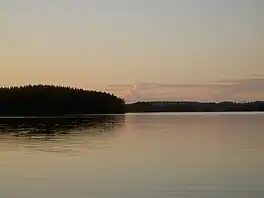A lake bifurcation occurs when a lake (a bifurcating lake) has outflows into two different drainage basins. In this case, the drainage divide cannot be defined exactly, as it is situated in the middle of the lake.
Examples
Vesijako (the name Vesijako actually means "drainage divide") and Lummene in the Finnish Lakeland are two nearby lakes in Finland. Both drain in two directions: into the Kymijoki basin that drains into the Gulf of Finland and into the Kokemäenjoki basin that drains into the Gulf of Bothnia.
Similarly the lakes Isojärvi and Inhottu in the Karvianjoki basin in the Satakunta region of western Finland both have two outlets: from Inhottu the waters flow into the Gulf of Bothnia through the Eteläjoki River in Pori and into lake Isojärvi through the Pomarkunjoki River. From lake Isojärvi the waters flow to the Gulf of Bothnia through the Pohjajoki river in Pori and through the Merikarvianjoki river in Merikarvia. In the Karvianjoki basin there have formerly been two other bifurcations, both eradicated by human actions.
Another example is Bontecou Lake, a shallow, man-made bifurcation lake in Dutchess County, New York.[1]
Lake Diefenbaker in Saskatchewan is a reservoir created by damming South Saskatchewan River and Qu'Appelle River. The lake continues to drain into the two rivers, but the Qu'Appelle receives a much enlarged flow (in essence, a diversion of flow from the South Saskatchewan) from the damming. Both rivers eventually drain into Hudson Bay via Lake Winnipeg and the Nelson River. Also located in Saskatchewan is Wollaston Lake, which is the source of Fond du Lac River draining into the Arctic Ocean and of Cochrane River draining into Hudson Bay and the Atlantic Ocean.
Isa Lake in Yellowstone National Park is a natural bifurcated lake which drains into two oceans. Its eastern drainage is to the Gulf of Mexico (part of the Atlantic Ocean) via the Firehole River, while its western drainage is to the Pacific Ocean via the Lewis River.
Peeler Lake in California's Hoover Wilderness is a natural bifurcated lake that lies along the Great Basin Divide. It has two outlets, one of which drains east into the Great Basin, and one of which drains west to the Pacific Ocean.
Lake Okeechobee in Florida is a particularly rare example of a trifurcation lake. Via the artificial Okeechobee Waterway, it flows east to the Atlantic Ocean through the St. Lucie River and west to the Gulf of Mexico through the Caloosahatchee River. Meanwhile, part of the lake's water naturally flows south through the Everglades into the Florida Bay. As a result of this artificial trifurcation, the Eastern Continental Divide of North America terminates at the lake rather than further south near Miami.
Heavenly Lake on the North Korea–People's Republic of China border.
Lake Pedder in Tasmania, as a result of damming, drains east as the Huon River and west as the Serpentine, a tributary of the Gordon.
List
- Systems that cross a continental divide
- The Chicago River and Calumet River artificially divert water from the Great Lakes to the Mississippi.
- The artificial Gatun Lake in Panama drains into the Atlantic and Pacific.
- Isa Lake in Yellowstone National Park drains to the Atlantic and Pacific.
- At the summit of Athabasca Pass in the Canadian Rockies is a small lake, the Committee's Punch Bowl, that drains both east and west.
- Lesjaskogsvatnet in Norway is the source of the rivers Gudbrandsdalslågen and Rauma, which eventually flow into the Skagerrak and the Norwegian Sea, respectively.
- Lake Okeechobee in Florida is a particularly rare example of a trifurcation lake. Via the artificial Okeechobee Waterway, it flows east to the Atlantic Ocean through the St. Lucie River and west to the Gulf of Mexico through the Caloosahatchee River. Meanwhile, part of the lake's water naturally flows south through the Everglades into the Florida Bay
- Wollaston Lake in Canada is the world's largest bifurcation lake, draining both northwest to the Arctic Ocean and northeast to Hudson Bay.
- Other systems
- Bontecou Lake in New York outflows into two watersheds, those of the Hudson and Housatonic rivers.
- Lake Diefenbaker – in Canada
- Lac Sainte-Anne located at N50.14222° W67.86399° north of Baie Comeau Quebec is shown on Canadian government topographical maps as draining into Rivière Toulnustouc and also into Rivière Godbout Est
- Inhottu, Isojärvi, Kivesjärvi, Kuolimo, Lummene, Vehkajärvi and Vesijako – in Finland
- Lake Manapouri in New Zealand has been modified as part of a hydroelectric scheme such that it drains (naturally) south to Foveaux Strait via the Waiau River and (artificially) west via a constructed tunnel to Doubtful Sound
See also
References
- ↑ Dutchess County Environmental Management Council. Natural Resource Management Plan for the Wappinger Creek Watershed (PDF) (Report). Village of Wappingers GulfFalls. pp. 1, 60. Retrieved September 4, 2018.
Further reading
- Not Any Usual Route (About bifurcation lakes in Finland)
- Kuusisto, Esko (1984). Suomen vesistöjen bifurkaatiot. (Abstract: The bifurcations of Finnish watercourses) Terra 96:4, 253–261. Helsinki: Geographical Society of Finland.(in Finnish)
External links
![]() Media related to Bifurcation lakes at Wikimedia Commons
Media related to Bifurcation lakes at Wikimedia Commons
